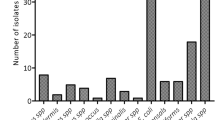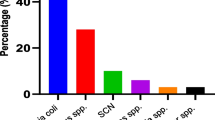Abstract
Bacterial isolates and their antibiogram resistance were studied using swab samples collected from transmissible venereal tumour (TVT) lesions within the vagina (ten dogs) and the vaginal mucosa of another ten healthy dogs. The samples were inoculated into the blood and on nutrient agar plates, incubated aerobically for 24 h at 37 °C and examined with hand lens. The characteristic appearance of different colonies, size, shape, arrangement, colour, pattern of growth, spreading or not and consistency were noted. Also, areas of haemolysis (α and β) were recorded. The cultures were then subjected to the Gram stain reaction. Based on the colonial characteristics, Gram stain and microscopic morphologies, organism suspected to be of significance were sub-cultured on nutrient agar and incubated aerobically for 24 h at 37 °C, after which the bottles were stored at 4 °C for subsequent use. Antimicrobial resistance profiles of the organisms were determined using the disc diffusion method. Staphylococcus spp. (44.4 %) and Escherichia spp. (66.6 %) were isolates from TVT lesions. Staphylococcus spp. (28.6 %), Proteus spp. (14.3 %), Enterobacter spp. (14.4 %), Escherichia spp. (28.6 %) and unidentified coliform spp. (14.3 %) were isolated from the normal dogs. Escherichia coli isolates were 100 % resistant to rifampicin and 20 % resistance to ciprofloxacin and ofloxacin. Staphylococcal isolates from the TVT dogs were resistant to the tested drugs except gentamycin (25 %) and ofloxacin (25 %). It is concluded that TVT lesions do not encourage bacterial growth. High multi-drug resistant organisms were found in both normal and TVT dogs.
Similar content being viewed by others
References
Chah KF, Nweze NE (2000) Antibiotic use in poultry production in Nsukka, Southeast Nigeria. Proc Nig Soc Anim Prod 26:69–72
Cheesbrough M (1984) Medical laboratory manual for tropical country, vol. 2: Microbiology. Tropical Health Technology, Norfolk, 189, 196
Das U, Das AK (2000) Review of canine transmissible venereal sarcoma. Vet Res Commun 24:545–546
Duguid RJ, Marmion PB, Swain RHA (1978) Medical microbiology, vol. 1, 12th edn. English Language Book Society, London, p 236
Eze CA, Anyanwu HC, Kene ROC (2007) Review of canine transmissible veneral tumour. Nig Vet J 28:54–77
Feldman EC, Nelson RW (1987) Canine and feline endocrinology and reproduction. Saunders, Philadelphia, p 564
Foxman B, Barlow R, D’arcy A, Gillespie B, Sobel JD (2000) Urinary tract infection: estimated incidence and associated costs. Ann Epidemiol 10:509–515
Gyles CL (2000) Pathogenesis of bacterial infections in animals. Iowa University Press, Ames, p 164
Huycke MM, Sahm DE, Gilmore MS (1998) Multiple drug resistance enterococci: the nature of the problem and an agenda for the future. Emerg Infect Dis 4:239–249
Jones TC, Hunt RD, King NW (1997) Veterinary pathology, 6th edn. Williams and Wilkins, Baltimore, 1190, 1220
Kahn CM (2005) The Merck veterinary manual, 9th edn. Merck, Whitehouse Station, pp 1263–1266
Kunin CM (1997) Urinary tract infections: Detection, prevention and management, 5th edn. Williams and Wilkins, Baltimore, p 419
Kunin CM, White LV, Tong HH (1993) A reassessment of the importance of “low-count” bacteriuria in young women with acute urinary symptoms. Ann Intern Med 119:454–460
Marrs CF, Zhang L, Tallman P, Manning SD, Somsel P, Raz P et al (2002) Variations in 10 putative uropathogen virulence genes among urinary, faecal and peri-urethral Escherichia coli. J Med Microbiol 51:138–142
Nak D, Misirlioglu V, Nak Y, Seyrek-Intas K, Tek HB (2005) Transmissible veneral tumour (TVT) with mammary gland metastasis in bitch. Vet Bilimleri Derg 20:99–102
Okeke IN, Lamikan GA, Edelman R (1999) Socioeconomic and behavioural factors leading to acquired bacteria resistance to antibiotics in developing countries. Emerg Infect Dis 5:18–27
Osborne CA, Lulich JP, Polzin DJ, Allen TA, Kruger JM, Bartges JW et al (1999) Medical dissolution and prevention of canine struvite urolithiasis. Twenty years of experience. Vet Clin N Am Small Anim Pract 29:73–111
Vogel PL, Korntebedde J, Deuright CH, Kass PH (1998) Wound contamination and antimicrobial susceptibility of bacteria. J Am Vet Med Assoc 214
World Health Organization (WHO) (2000) Essential drugs monitor. No. 28 and 29, 7–9
Author information
Authors and Affiliations
Corresponding author
Rights and permissions
About this article
Cite this article
Eze, C.A., Ugwu, J., Eze, J.I. et al. Characterisation of the bacterial isolates from transmissible venereal tumour lesions of dogs and their antibiogram resistance in Nsukka area, Southeastern Nigeria. Comp Clin Pathol 23, 641–645 (2014). https://doi.org/10.1007/s00580-012-1664-6
Received:
Accepted:
Published:
Issue Date:
DOI: https://doi.org/10.1007/s00580-012-1664-6




